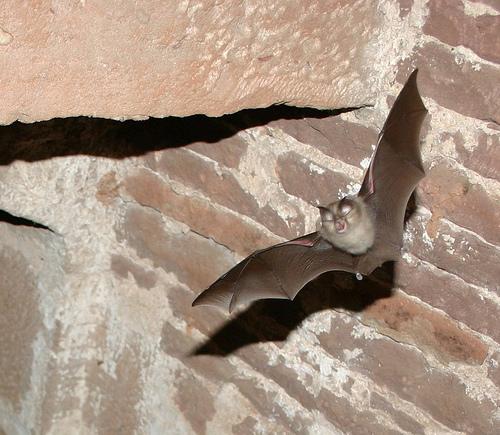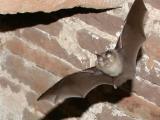An international research team has identified two novel coronaviruses (CoVs) in Chinese horseshoe bats that are closely related to the SARS-CoV and can infect human cells, which supports the hypothesis that the SARS virus originated in bats and suggests that it may have the capacity to jump directly from bats to humans, instead of passing through another animal first.
The new findings, reported today in Nature, come from a genetic analysis of samples taken from a horseshoe bat colony, a year-long effort that took place in Kunming, China, in the southwestern part of the country in Yunnan province. The team, which included investigators from China, Australia, Singapore, and the United States, found at least seven different strains of SARS-like viruses circulating in the bats.
Genetic sequencing revealed that two of the novel viruses were more closely related to SARS-CoV than any virus seen before. And for the first time, the research team was able to isolate a SARS-like virus from a bat fecal sample, which allowed them to run a series of tests to see if it could infect different human and animal cells.
During the SARS outbreak a decade ago, Chinese researchers concluded that civets were the immediate source of the virus in human infections, which led the government to order the slaughter of all civets in captivity and ban killing and cooking the animals. However, researchers haven't determined if they are the virus's natural reservoir. In previous studies, Chinese researchers had found CoV sequences similar to the SARS virus in bats, monkeys, snakes, and civets.
Global health officials suspect that bats might be the reservoir of the Middle Eastern respiratory syndrome coronavirus (MERS-CoV), especially after researchers in August reported finding a virus fragment in a bat that appeared to match the one infecting people in a handful of Middle Eastern countries. Also, diverse SARS-like CoVs have also been reported in bats in China, Europe, Africa, and North America.
Same receptor as SARS virus
In the new study, researchers found that the virus they isolated and cultured from bat guano uses the same human receptor as SARS-CoV to infect human cells. The angiotensin-converting enzyme 2 (ACE2) receptor is mainly found in pneumocytes, deep in human lungs.
In a series of lab tests using different species' cell lines, researchers found that the virus they isolated can infect human alveolar epithelial cells, pig kidney cells, and the bats' own kidney cells, but cannot infect six other cell lines that they used.
In cross-neutralizing antibody tests using nine blood samples collected from SARS patients in 2003, the team found that seven were able to completely neutralize an infectious dose of the bat SARS-like virus.
The team wrote that, in view of the findings of diverse CoVs in bats, they wouldn't be surprised if further surveillance found some that are even more closely matched to the SARS virus. Bat coronavirus findings in the Middle East, China, and other parts of the world suggest that the viruses remain a substantial global public health threat, they added.
Evidence of SARS origin
Vincent Racaniello, PhD, a Columbia University virologist who writes Virology Blog, told CIDRAP News that the findings are the best evidence yet that SARS-CoV originated in bats.
"The hypothesis has been that a bat progenitor to the SARS-CoV that could bind ACE2 initiated the SARS outbreak, but as that virus had never been isolated, the hypothesis was just that," he said. "Clearly an ACE2-binding CoV that circulates in bats is a prime candidate to start the SARS epidemic."
Another main message from the findings is that there are clearly SARS-CoV-like viruses circulating in bats that could infect humans, Racaniello said. "How many are out there, and their threat to humans, is a good question. All of this shows why it is important to know the viruses infecting the animals around us."
Peter Daszak, PhD, senior coauthor of the study and president of EcoHealth Alliance, a New York City–based nonprofit group that studies emerging infectious diseases, said in a statement that the findings are a reminder of the need to protect bats from human-driven environmental changes and to devise public health measures to reduce the risk of disease transmission.
He said the risk is substantial, because it's not unusual for bats to be used as a food source in China and other parts of Asia.
The study was funded in large part by grants from US government agencies, including the US Agency for International Development (USAID) PREDICT project, geared toward pathogen discovery in high-risk wildlife species in emerging disease hotspots.
Ian Lipkin, MD, a well-known virus researcher based at Columbia University's Center for Infection and Immunity, said in an EcoHealth Alliance statement that the study hasn't resolved the definitive source of the SARS virus. "Nonetheless, it does provide compelling evidence that an intermediate host was not necessary," he said.
Caution about infection assumptions
One infectious disease expert, however, cautioned that the new findings don't draw a direct connection between infected bats and infected humans.
Michael Osterholm, PhD, MPH, director of the University of Minnesota's Center for Infectious Disease Research and Policy, publisher of CIDRAP News, said there is little doubt that bats are a natural reservoir for this virus and play a role in human CoV infections, but the biology and natural history of an infectious agent are two different issues.
Transmission typically involves a complex chain of events, beyond the basic ability of an infectious agent to infect a cell in lab culture, he said. For example, the mode of transmission, such as saliva from a bite as the key factor in rabies transmission from bats, affects how a pathogen spreads to humans.
Osterholm said that if bats shed the virus primarily in their feces, scientists need to explore the dynamics of how the pathogen might reach and infect humans.
The new study adds to the understanding of how humans are infected with SARS, he said. "It's like piecing together the origin of the human species. Each year we learn new pieces about how it happened."
Ge XY, Li JL, Yang XL, et al. Isolation and characterization of a bat SARS-like coronavirus that uses the ACE2 receptor. Nature 2013 Oct 30 [Abstract]
See also:
Oct 30 EcoHealth Alliance press release

















